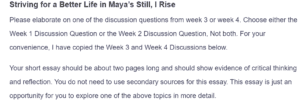Striving for a Better Life in Maya’s Still, I Rise
It has been human misfortune to be in problems from time immemorial. However, the efforts made by thousands of people to alleviate their lives and be in a position to bolster and change their adverse situations have been inspirational to many people. Maya Angelou’s Still I Rise provides a truly remarkable work of art that is nothing short of an inspiration to persons still struggling to have a dream of better days to come. The poem’s core intention is to empower people. It speaks of the struggle that people find themselves in, not because they put themselves in it but because of the possibility that it was not their own fault. Therefore, they are in a vicious struggle not to fall and drown in the agony that so often surrounds the weak, minorities, and prejudiced members of society. Still, I Rise is a riveting poem that also provides solace to the soul not to give in to despair. It explores the notion of the abuse of authority and power by the elite, the unjust justice system, and even the police. In a nutshell, the poem offers hope to the downtrodden to hold on to hope that better days are coming, regardless of the time spent hoping. With this in mind, it suffices to say that this paper explores the theme of striving for a better life in the poem Still I Rise.
Foremost, it is vital to point out that this riveting work of art is well-endowed with figurative language, which provides a hymn to the oppressed individuals’ souls and minds. Without a doubt, Maya speaks out boldly in the poem, whereby she insists on the fact that regardless of the tribulations of the oppressed or the cruelty and the prevailing circumstance, the oppressed persons will rise, and the captives will trounce over adversities. In the poem, the poet poses defiantly at the oppressive authorities, asking, “…Did you want to see me broken? Bowed head and lowered eyes? Shoulders falling down like teardrops, Weakened by my soulful cries?” (Angelou, 1994). In the reader’s mind, the poet taunts the oppressor with defiant questions, mocking them whether they wanted to see her crestfallen and sad about her situation. The defiance in the questions hints at a spirit that does not cower before adversity.
Nonetheless, it is vital to point out that inasmuch as the background of the poem is on slavery and the notion of civil rights as the driving force, the poem possesses an alluring universal appeal, in that all persons from all walks of life, be they a minority, a people under an oppressive regime, are all able to put on a brave face in the face of humiliation, suffering, and injustice. The repetition of the refrain, ‘I rise,’ emphasizes the poet’s message of hope in the face of adversity.
Again, the poet’s use of literary devices has been used efficaciously to advance the message of the poet to her readers. From the onset of the poem, the poet employs stylistic devices, including the metaphor when she says, “I am the dream and the hope of the slave.” To highlight the symbolic nature of her defiance against the oppressive ‘you,’ which is the government or institutions that hold on to the power and lives of the oppressed people. Besides, the poet has also used the simile to explain how she would rise in the face of adversity in the poem Angelou posits, “But still, like dust, I’ll rise” (Angelou, 1994). This defiance seeks to taunt the oppressor that inasmuch as the body has been subjected to the scourge and suffering that they have undergone, the spirit is still wild and free and would never be captive.
To sum up, the speaker in the poem is defiant, and it serves to serve the oppressive government a dose of their own medicine through defiance that seeks to prick them where it hurts the most. Doubtless, it is through defiance that most agendas are achieved, and by so doing, the body, regardless of the pain it suffers, solace is always on the horizon.
References
Angelou, M., & Broun, H. H. (1994). Still, I rise. Jeffrey Norton Publishers.
ORDER A PLAGIARISM-FREE PAPER HERE
We’ll write everything from scratch
Question
Striving for a Better Life in Maya’s Still, I Rise
Please elaborate on one of the discussion questions from week 3 or week 4. Choose either the Week 1 Discussion Question or the Week 2 Discussion Question, Not both. For your convenience, I have copied the Week 3 and Week 4 Discussions below.

Striving for a Better Life in Maya’s Still, I Rise
Your short essay should be about two pages long and should show evidence of critical thinking and reflection. You do not need to use secondary sources for this essay. This essay is just an opportunity for you to explore one of the above topics in more detail.
WEEK 3 DISCUSSION QUESTION: Please discuss the theme of struggle and suffering or the theme of striving for a better life in one poem by Langston Hughes OR in one poem by Maya Angelou OR in one poem by E. A. Robinson. Your choice of poem should be from the required readings in week 3.

Striving for a Better Life in Maya’s Still, I Rise
OR
WEEK 4 DISCUSSION DISCUSSION: Please discuss the approach to or feeling about death in one poem by Emily Dickinson OR in one poem by John Milton OR in one poem by W. H. Auden (from the required readings). Your choice of poem should be from the required readings in week 4.

